Sapodilla is a tropical evergreen tree growing in many countries for export. This tree can also be grown in home gardens and containers. Sapodilla fruit is round or egg-shaped. It is about 2 to 4 inches in diameter. The peel of the fruit is brown when it ripens. The flesh inside the fruit varies in color (yellow to brown) for different types. The amount of latex is high when the fruit is raw, but it decreases when it is ripe.
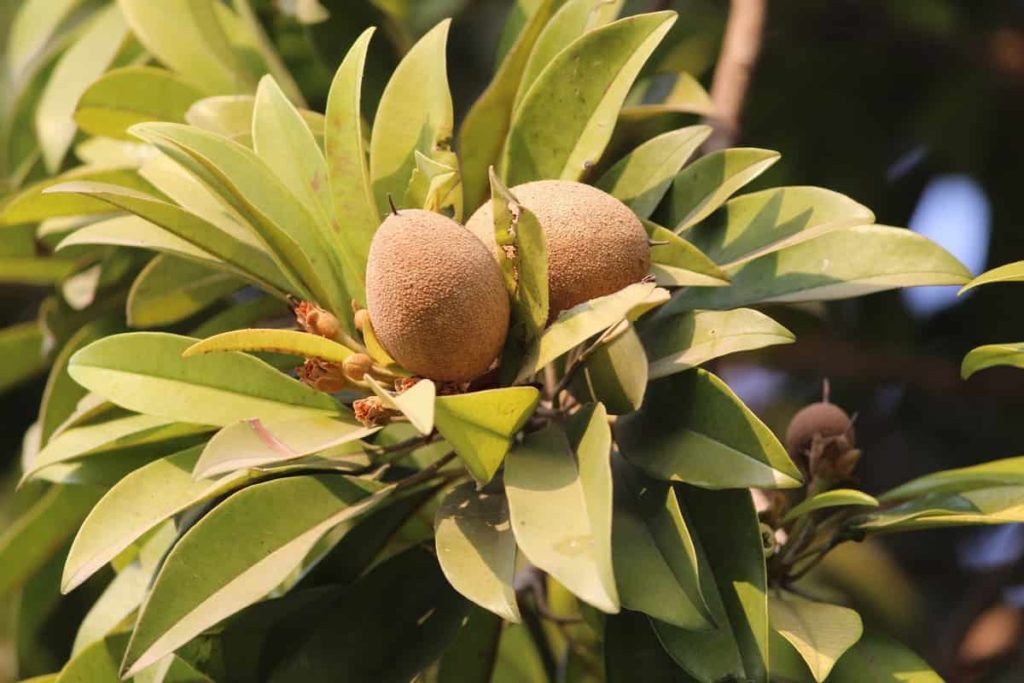
The fruit’s flesh is smooth and granular in texture and tastes sweet. Much of the propagation for growing the Sapodilla tree is done through seeds that will remain viable for years, although some commercial farmers use grafting and other methods. Once germinated, pay some patience as it takes five to eight years to grow a Sapodilla tree of endurance age.
How to grow Sapodilla/Chikoo/Sapota from seed to harvest
How long does it take for Chiku to bear fruit from seed?
- Sapodilla tree is tolerant of most conditions, but with good drainage, most prefer a sunny, hot, and frost-free spot in any soil.
- The grafted tree starts bearing fruit from the third year of planting, but commercial production is achieved only after the seventh year. The time it takes for the Sapodilla tree to reach the fruit maturity stage from the flowering stage is about 4 to 6 months.
- The Sapodilla fruit is yellowish-brown; its leaves are shiny and evergreen, and the flowers are white. Mature Sapodilla usually produces Sapodilla fruit twice a year. The Sapodilla plant requires well-drained sandy soil.
- Seed-planted trees take 7 to 10 years to bear fruit, and the grafted tree takes 3 to 5 years to bear fruit. The best time to plant is in spring when it rains well to set up a young tree. Avoid planting in winter as Pouteria Sapodilla is sensitive to cold temperatures.
Can I grow Sapodilla from seed?
- Sapodilla leaves are 8 to 13 centimeters long and pointed at both ends. The fruit is brown, fleshy, oval to round, 3 to 8 centimeters long, with five or more bright dark brown seeds.
- Sapodilla is often propagated by seeds, which remain viable for many years when kept dry. After they are germinated, it takes 7 to 9 years to bear fruit. Since seeds cannot be true, vegetative propagation is required. Veneer grafting with seedlings as rootstock is the best method.
- However, seed-grown Sapodilla trees can take up to 7 years to produce fruit. Choose ripened Sapodilla fruit and open it with a knife. Remove the Sapodilla seeds and wash them with all the pulp. To sprout a Sapodilla seed, let the fresh seed dry and plant it in a pot of moist soil.
In which season does Chikoo grow?
Sapodilla is planted in the field in July or August in the prepared pits. Block plantation can be carried out at a distance of 8 meters in the square system of the plantation. The planting distance could be reduced to 7 meters if this is done on light soils. The two main flowering seasons are October-November and February-March, and the corresponding two harvesting seasons are January-February and May-June.
In case you missed it: Growing Sapota in Containers, Pots (Chikoo/Sapodilla)
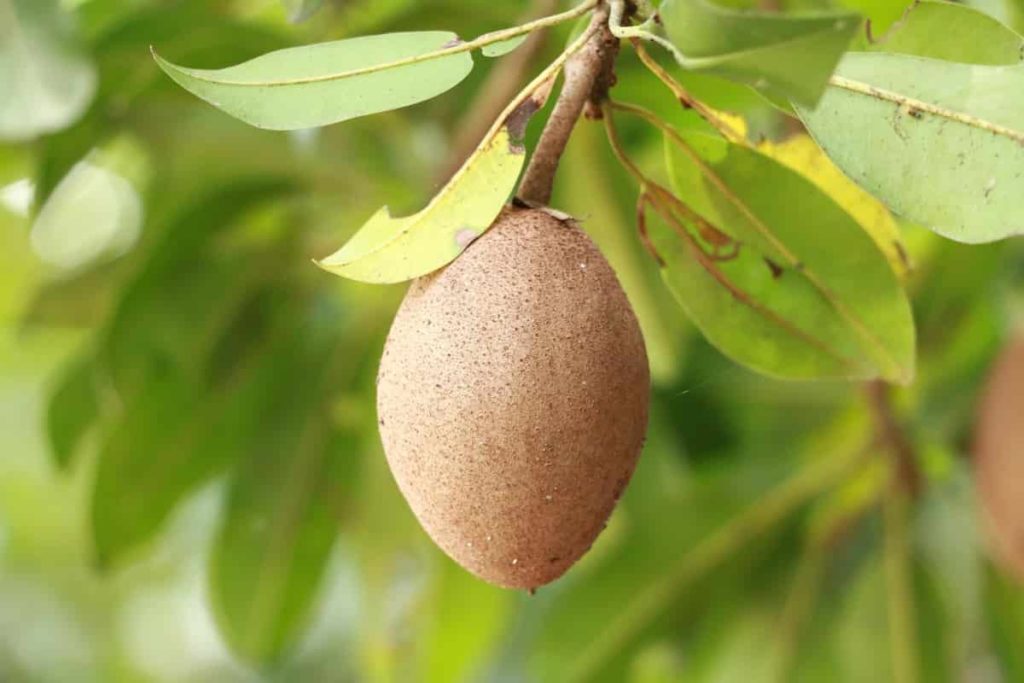
Can we grow Chikoo in pots?
- Sapodilla is as sweet as a Peach. If you want to enjoy it at home, you can prepare it through the propagation of the Sapodilla plant. You can grow Sapodilla through seeds or graft them. Sapodilla trees do not grow well in cold weather, but mature trees tolerate cold as long as the temperature is not falling regularly.
- It is better to place a black Sapodilla at least 30 feet away from anything that can shade it. As a potted indoor or yard plant, give this plant full sun whenever possible. This will likely suffice if you have a west-facing sunny window.
- Sapodilla trees grow well in the pot as long as you provide a pot of appropriate size for root growth. Choose a pot 18 to 24 inches in diameter and 20 inches in Sapodilla height, with proper drain holes.
How do you grow Chikoo seeds?
- Choose ripened Sapodilla fruit and open it with a sharp knife. Remove the Sapodilla seeds and wash them with all the Sapodilla pulp. Crack each Sapodilla seed coat before planting to increase the chances of the germination process. Then place the seed between the two wooden planks and put light pressure on the top. You should place the seed in a paper towel and keep it in a zip lock bag.
- It takes about two weeks for Sapodilla seeds to germinate. After this time, you should open the zip lock bag and see the seeds must have germinated and developed a root; Gently remove the Sapodilla seeds from a paper towel and plant them in pots or appropriate plastic bags 1 centimeter deep filled with a good potting mix.
- Use good quality, well-draining soil to grow Sapodilla. You should choose an area with plenty of sun, at least 6 to 8 hours daily. Push the Sapodilla seed about an inch deep and into the soil in water. Once the tree germinates, it can take 5 to 8 years for a Sapodilla tree to start bearing fruit.
- You should plant the pointed side of each seed about 1/2 inch above the soil surface. Let the plant water each seed deeply. Continue to use deep water during 2 to 4 weeks of germination and through the growth of Sapodilla seedlings. Once the seedlings have overtaken their pots, transfer them to larger containers.
Why is Sapodilla not fruiting?
- Cold stress or wet feet can adversely affect the Sapodilla, resulting in the Sapodilla fruits but also in the death of the tree. In addition, although the tree like the sun, especially immature trees, are sunburned, so it is necessary to cover them and move or provide shade cloth.
- Sapodillas are remarkably tolerant trees. Ideally, they prefer a sunny, warm, frost-free location. They perform well in humid and arid environments, though permanent irrigation will help the tree flower and fruit.
How do I prune a Chikoo plant?
- Being an evergreen tree, there is no need for regular pruning, but regulation of vegetative growth is essential to promote the productivity and quality of fruits. In June, dry stems and branches, crowded branches originating in the canopy’s interior, and those criss-cross branches should be pruned.
- Remove branches with a narrow crotch angle as they can break under heavy fruit loads. As trees mature, pruning is done to control the height and width of trees and remove damaged or dead wood. You should keep the maximum height of the tree is 12 to 15 feet.
- Pruning is usually done during winter to shape and reduce the overcrowding of branches. Pruning is necessary because flowers and fruits are borne on these branches, which receive maximum air and sunlight.
In case you missed it: How to Grow Swiss Chard from Seed to Harvest: Check How this Guide Helps Beginners
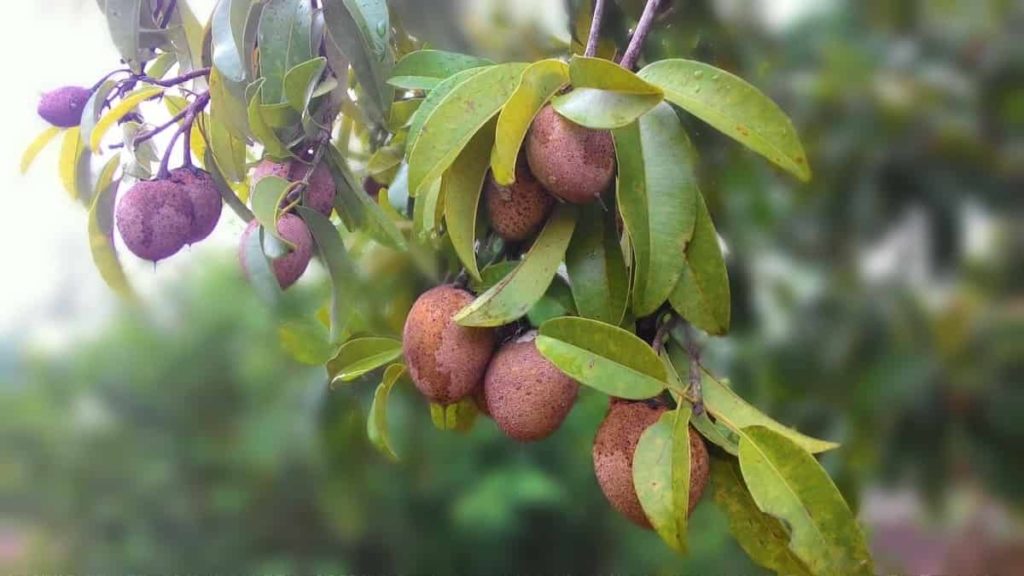
How do you fertilize a Sapodilla tree?
- When new growth begins after planting white Sapodilla trees, apply 113 grams of 6-6-6-2 nitrogen, phosphate, potash, and magnesium with minor ingredients containing 20 to 30% nitrogen from organic fertilizer sources. You should repeat this every 6 to 8 weeks for the first year.
- Mulch the newly planted trees with 2 to 6 inches of wood chips, and keep away 8 to 12 inches from the stem of each tree.
- Fertilize young trees when new growth appears every year for the first three years. Fertilize more nitrogen, such as 6-6-6-2, no more than 226 grams per tree in the first year and no more than 362 grams in the second year, eventually graduating from 1.3 to 2.3 kg in the third year.
- Additional care for Sapodilla trees advises fertilizing young trees with 8% nitrogen, 2-4% phosphoric acid, and 6-8% potash with 113 grams every two or three months and gradually increasing to 453 grams. After the first year, two or three applications a year are enough.
- Sapodilla trees require foliar sprays of NPK, magnesium, and Zink during fruit sets to improve the size of the fruit. In addition, the application of 8:12:24:4 fertilizer 100 grams per tree is beneficial for the growth of Sapodilla trees.
How tall does a Sapodilla tree grow?
- The Sapodilla tree is a medium to large tree with a pyramidal to rounded canopy. These long-lived trees grow slowly but can reach 60 to 100 feet in height after many years. Sapodilla trees adapt well to subtropical and tropical climates.
- Some of the Dwarf variety trees grow up to 20 to 25 long and produce delicious Sapodillas with smooth pulp in brown with a sweet scent.
- In the wilderness, this tree can be up to 100 feet in height. The trunk produces a hard bark with gummy white latex called chicle; dark green leaves are oval to elliptic and shaped with bell-like flowers.
Does Sapodilla tree need full sun?
- Sapodilla requires 5 to 7 hours of direct sun and bright light to thrive, so place the container in a fully sunny location, and the location should be cold-free.
- Sapodilla trees require bright light and direct sun. If possible, twelve hours of bright sunlight is perfect for plant growth and fruit production.
- Choose a site with plenty of bright sunlight for the best tree growth and fruit production. The location should also be free of other trees because Sapodillas can grow larger if not pruned to control their size.
- The young Sapodilla plant is damaged due to high sunlight and dry and hot air. You can grow Sapodilla in both arid and humid environments. The Sapodilla plant can survive for 6 to 7 days without water in summer and 20 to 25 days in water in winter.
- Suppose you’re looking to grow Sapodilla in cold climates. The Sapodilla fruit tree can survive only in tropical and subtropical climates. If the temperature falls below freezing, the tree will die.
In case you missed it: How to Grow Oranges from Seed to Harvest: Check How this Guide Helps Beginners
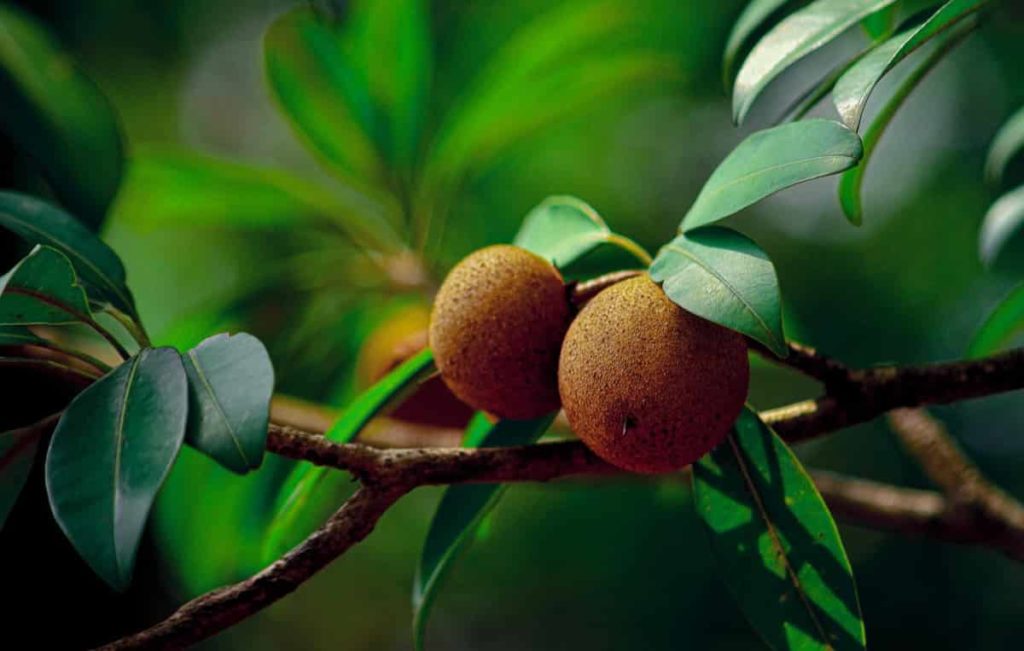
How do you care for a Sapodilla tree?
- Once seeds germinate, pay some patience as it takes five to eight years to grow a Sapodilla tree of endurance age. As mentioned, the fruit tree is tolerant of most conditions, but with good drainage, most prefer a sunny, hot, and frost-free spot in any soil.
- Most mature Sapodilla trees don’t get water, but irrigation in the dry season will increase productivity. Newly planted trees require small and often food to be established. Fertilizers containing 6-8% nitrogen, 2-4% available phosphoric acid, and 6-8% potash give satisfactory results.
How often should I water my Sapodilla?
- You should water during long dry periods (such as five or more days with minimal rain) and newly planted Sapodilla trees (first three years) twice a week. Once the rainy season arrives, the frequency of water may decrease or stop.
- You’ll need to water the newly planted Sapodilla twice a week on alternate days for the first week and after one month for the next 6 to 8 months. Once the tree is established and 4 to 5 years old, it won’t need to be watered again and again.
How fast do Sapodilla trees grow?
- Sapodilla trees are slow-growing trees when grown from seeds, and a Sapodilla plant takes eight to nine years to grow. Sapodilla trees grow well in containers; choosing a dwarf type of Sapodilla tree grows in compact areas and sizes.
- Much of the propagation for growing the Sapodilla tree is done through seeds that will remain viable for years, although some commercial farmers use grafting and other methods. Sapodilla trees are long-lived trees that grow slowly but can reach 60 to 100 feet in height after many years.
How do you ripen raw Sapodilla?
- Sapodilla takes four months from flower to fruit maturity. You can pick fruit by hand or cut with a round ring with a net bag fixed on a long bamboo.
- Sapodilla being a climacteric fruit, has to be artificially ripened. Raw fruits can be ripened at 20°C to 25°C by applying ethephon and stored for five weeks. Ripened ones can be stored at 2°C to 30°C for six weeks.
- You can easily ripen Sapodilla through carbide. For this, keep Sapodilla in a box, tie one to two teaspoons of carbide in a cotton cloth and keep it in the box. Now place this box somewhere for 48 hours and cover it with a sack or plastic. Within 48 hours, you’ll see that the Sapodilla is ready.
- Add your fruit to a paper bag, seal it, and wait a few days. The key here is ethylene. Ethylene is a natural gas given by fruit that helps in ripening. To speed things up further, you can add an Apple or Banana.
In case you missed it: How to Prepare the Soil for Pineapple Plants: Best Soil Mix, pH, Compost, and Recipe
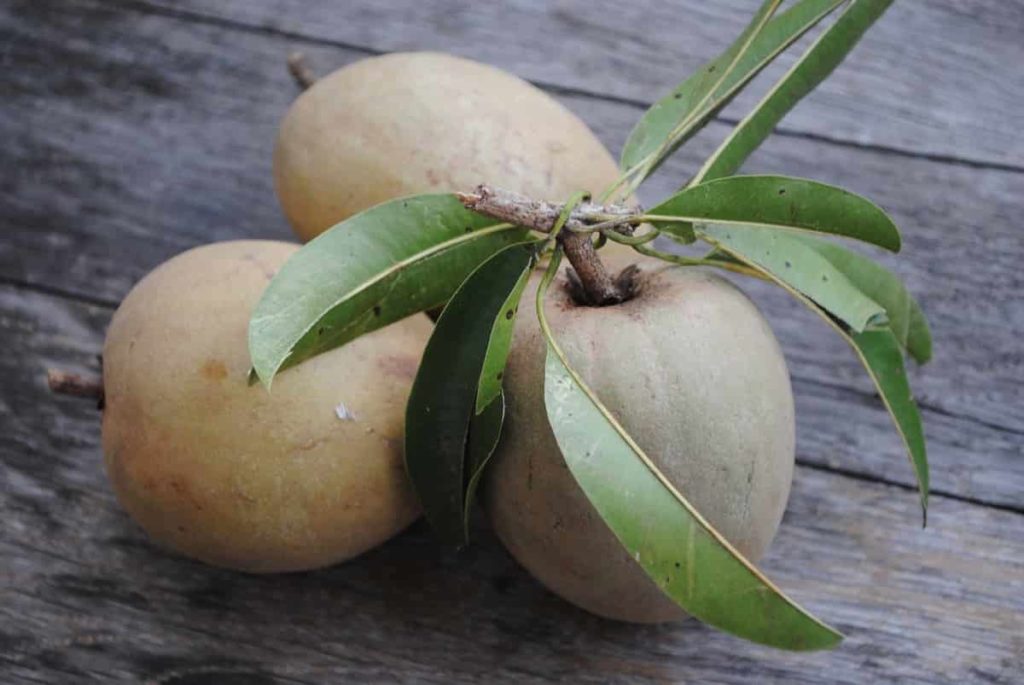
How do you know Sapodilla is ripe?
- To tell if Sapodilla is ready to eat, gently scratch a little of its brown fuzz; if the skin below is green, the fruit is not ready; Sapodilla is usually eaten fresh by cutting the fruit and extracting meat from a spoon.
- Knowing whether Sapodilla is ripened or not is easy to tell. At first, the skin will look a little wrinkly, almost like a baked Potato. The fruit will be easily yielded with gentle pressure from the thumb without mushing. Sapodilla will have a well-known fragrance of fresh Pumpkin and brown sugar.
What kind of soil does Sapodilla like?
- For Sapodilla cultivation, suitable soil types are deep alluvium, sandy loam, and medium black soil. The pH of the soil for Sapodilla should be around 6 to 8. The shallow clay type of soil is not suitable for Sapodilla farming. Sapodilla is a tropical fruit and requires a warm, humid climate for growth and development.
- Sapodilla plants require rich and well-drained soil. You can prepare a mixture of soil, sand, and perlite for the pot, which makes drainage because its roots do not like wet.
Why do Sapodilla flowers fall?
- The crop can be planted in areas with heavy rainfall by the end of September. Sapodilla flowers fall as a result of inadequate irrigation.
- Mulch helps prevent water evaporation and also maintains moisture levels. In the absence of rain, water slowly and deeply will never allow the soil to dry up. Plants face stress when they do not have adequate nutrients. Most plants respond well to feeding with a layer of fertilizer or slow-release fertilizer in the middle of spring and summer. However, too little and too much sun can stress the plant and cause flowers to fall.
Which system of planting system is followed in Sapodilla?
- Sapodilla can be propagated through grafting. The ideal planting season is from June to December. 8 x 8 m for conventional plantations.
- The distance of normal plants is 8.5 meters to 10 meters, but there is a new method of planting called high-density planting (HDP). In high density, the distance between plants is reduced to 5 x 5 meters so that more plants can find space.
Can we grow Chikoo from cutting?
- Sapodilla can be propagated through seeding, grafting, or layering. However, commercially the follow-up process is softwood grafting on Ryan Seedlings. This method has replaced the earlier process called approach grafting. Sapodilla is essentially slow growth when grafted onto a rayon, but the tree lasts longer.
- You can propagate the Sapodilla in a pot or directly through seeds sown in the garden soil. Although some gardeners also use grafting and other methods.
In case you missed it: How to Grow Apples for Beginners: A Guide to Planting to Harvesting

What is the yield of Sapodilla fruit per tree?
- Almost Sapodilla trees take four months to harvest the fruit, with two seasons (December–February, and May-June). The yield of Sapodilla is 175 kg per tree or 11.8 tonnes per hectare at the rate of 67 trees planted at a distance of 40 feet.
- Sapodilla is a climacteric fruit whose quality improves after harvesting, but immature fruits should never be harvested. A well-grown and well-nourished Sapodilla tree yield 2,500 to 3,000 fruits during its productive age.
Conclusion
The maintenance of the Sapodilla plant is not difficult, but it requires vigilance. Fertilize the Sapodilla plant in the spring just before the new growth appears. You can grow very easily in home gardens. The fruit of Sapodilla is yellowish brown. Its leaves are shiny and evergreen, and the flowers are white. Mature Sapodilla usually produces fruit twice a year. By providing all the Sapodilla’s needs, you will be rewarded with a bountiful harvest.
- Where to Place Indoor Plants in Your Home
- How to Grow Tomatoes Organically at Home: A Comprehensive Guide
- Organic Gardening on a Budget: Low-Cost Methods and Materials
- Gongura Seed Germination and Planting Methods
- Cabbage Seed Germination and Selection
- Broccoli Seed Germination and Selection
- Asparagus Seed Germination and Variety Selection
- Seasonal Flower Gardening: Best Practices for Spring, Summer, Fall, and Winter
- How to Grow Hibiscus from Flower
- Plantation Ideas for Home Decoration: A Beginners Guide
- Flower Garden Designs and Layouts for Beginners
- Planting and Spacing Techniques in Papaya: A Beginner’s Guide
- Growing Gold: Essential Techniques for Planting Pineapples
- How to Make Kalanchoe Plant Bushy: Home Remedies and Solutions
- 11 Reasons Why Your Gardenia is Not Blooming: Home Remedies and Solutions
- Eco Elegance: The Guide to Designing a Drought-Tolerant Landscape
- Gardening on a Slope: Strategies for Hillside Landscaping
- Nourish and Flourish: Top Organic Mulches for Thriving House Plants
- Everything You Want to Know about Indian Mogra Flower: Discover Uses and Growing
- Green Thumb Success: Expert Tips for Cultivating Greenhouse Pumpkins All Year Round
- Maximize Growth & Flavor: The Ultimate Guide to Companion Planting in Herb Gardens
- How to Control Rhododendron Problems Naturally: Home Remedies and Organic Ways to Fix Them
- Natural Magic: The Remarkable Benefits of Cinnamon for Plants
- Best Steps to Revive Dying Tulip with Natural and Organic Treatment
- 10 Reasons Why Your Angel Trumpet is Not Blooming: Remedies and Treatment
- How to Fix Periwinkle Leaf and Flower-Related Problems: Natural Remedies and Solutions
- How to Fix Zinnias Leaf and Flower Problems: Discover Natural and Home Remedies
- Organic Steps to Induce Lemon Tree Flowers: A Comprehensive Guide
- Bloom Booster: Crafting the Perfect Homemade Bougainvillea Fertilizer
- Optimizing Growth: A Guide to Applying NPK Fertilizer for Potted Plants
- 10 Best Homemade Fertilizers for Rubber Plant: DIY Recipes and Application Method
- How to Boost Female Pumpkin Flowers: Effective Steps for More Flowers and High Yields
- Transform Your Indoor Garden: Top Benefits of Pink Salt for Houseplants
- 10 Best Homemade Fertilizers for Peacock Plants (Calathea): Easy DIY Guide
- Unlock Blooms: 9 Reasons Why Your Potted Chrysanthemum is Not Blooming
- 8 Reasons Why Your Potted Hibiscus is Not Blooming: Fix it with Simple Solutions